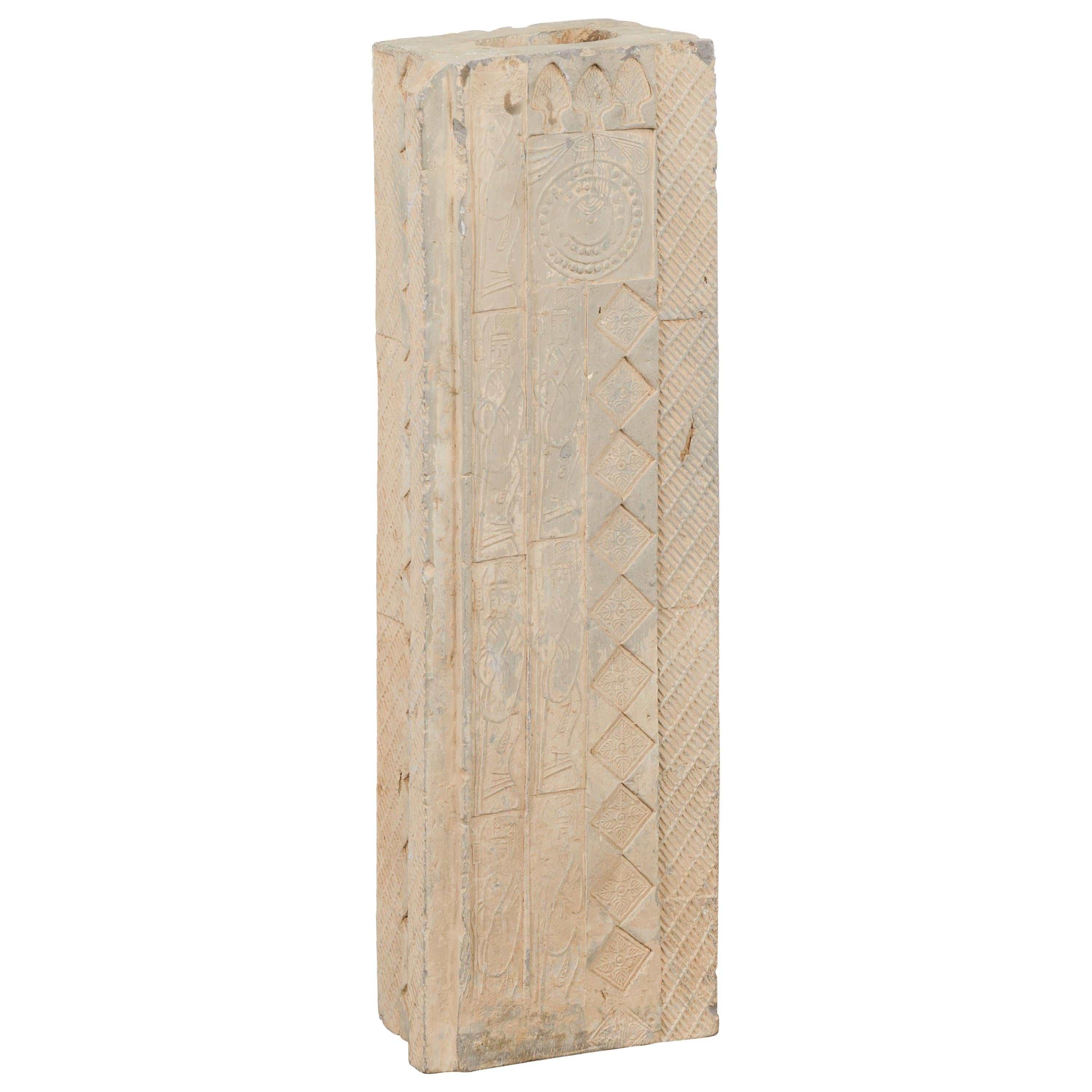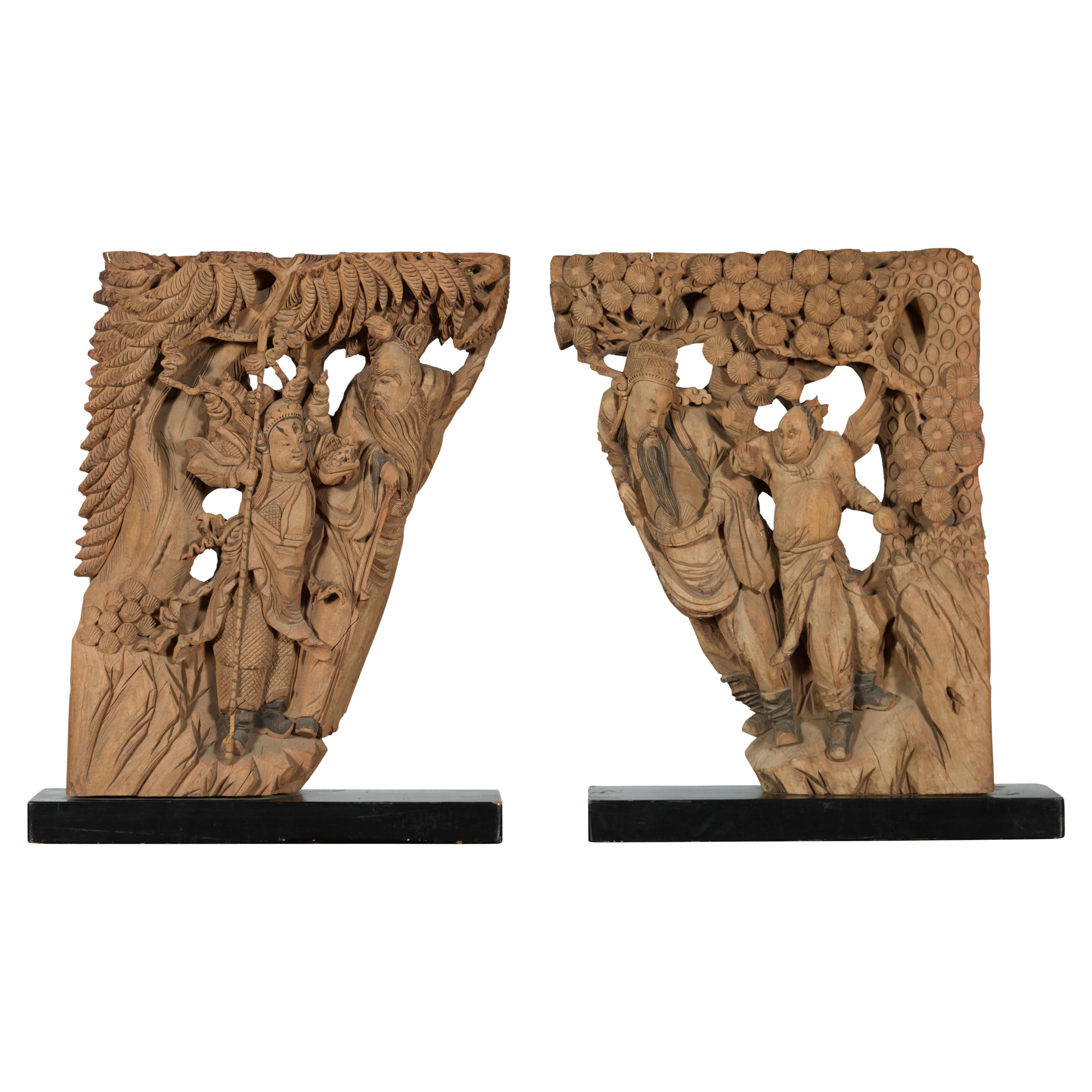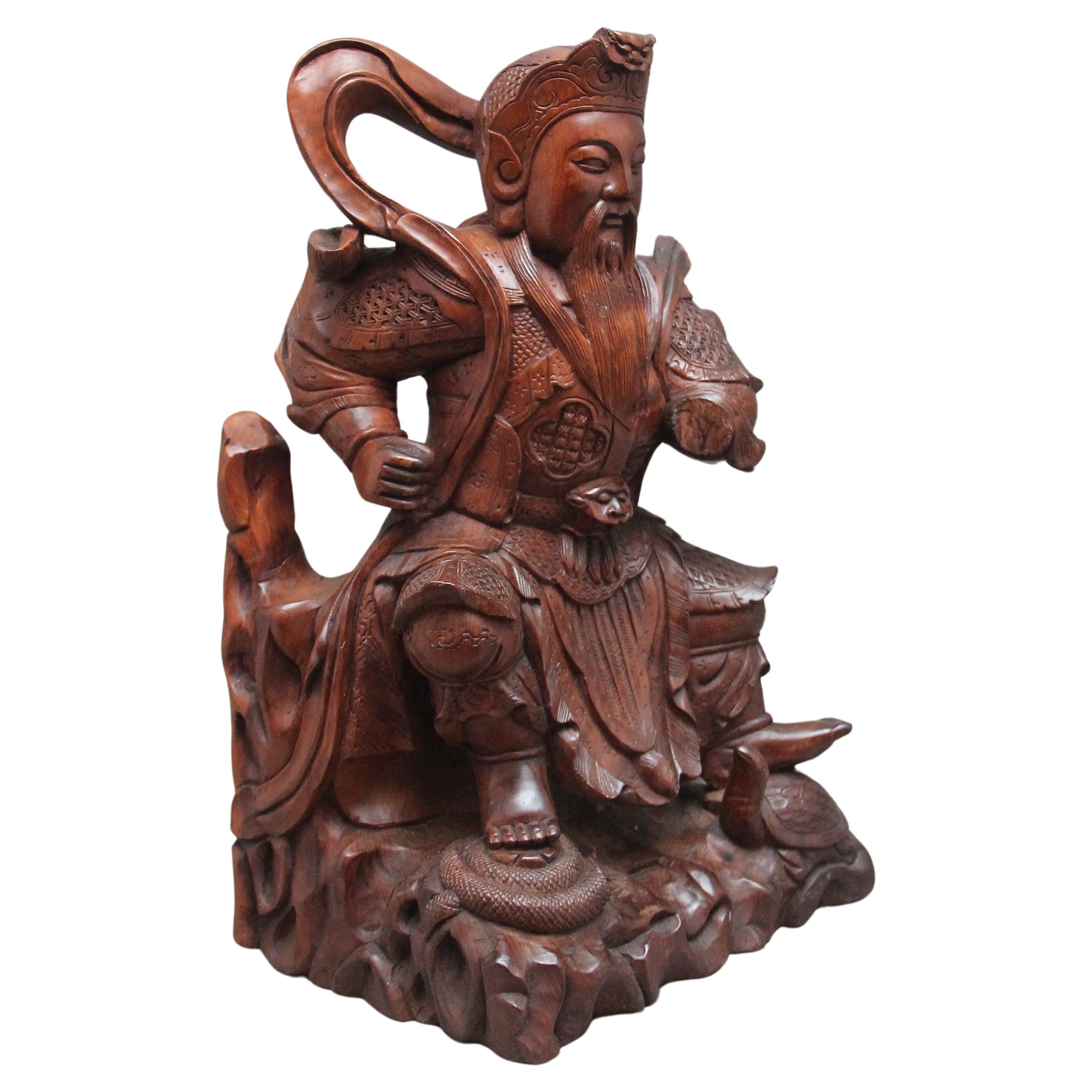Items Similar to Hand-Carved Chinese Temple Carving from the 19th Century with Traces of Paint
Want more images or videos?
Request additional images or videos from the seller
1 of 9
Hand-Carved Chinese Temple Carving from the 19th Century with Traces of Paint
About the Item
This splendid antique Chinese temple carving was hand-carved from a solid block of wood during the 19th century. On its main side it displays an enjoyable scene with five Chinese characters, probably a meeting of people of letters. Each detail is carefully carved on this unique item and enhanced by polychrome traces which allow us to fully appreciate the traditional costume of the characters. On the left a pleasant character, likely a monk, is dancing and playing tambourine. On top the block shows holes that may have, with the tenon and mortise technique, been used to connect it with other similar blocks in its temple. This Chinese relief from the 19th century would be a wonderful and uncommon decorative for most rooms and would no doubt be a tremendous conversation starter.
- Dimensions:Height: 7 in (17.78 cm)Width: 24 in (60.96 cm)Depth: 5 in (12.7 cm)
- Materials and Techniques:
- Place of Origin:
- Period:
- Date of Manufacture:19th Century
- Condition:Wear consistent with age and use.
- Seller Location:Yonkers, NY
- Reference Number:
About the Seller
5.0
Platinum Seller
These expertly vetted sellers are 1stDibs' most experienced sellers and are rated highest by our customers.
Established in 1968
1stDibs seller since 2009
915 sales on 1stDibs
Typical response time: <1 hour
- ShippingRetrieving quote...Ships From: Yonkers, NY
- Return PolicyA return for this item may be initiated within 3 days of delivery.
More From This SellerView All
- Pair of Chinese 19th Century Hand Carved and Painted Temple Guardian LionsLocated in Yonkers, NYA pair of Chinese sculpted and polychromed temple guardian lions architectural wood carvings. Born in China during the 18th or 19th century, each...Category
Antique 19th Century Chinese Sculptures and Carvings
MaterialsWood
- Pair of Chinese 19th Century Hand Carved Wooden Temple Corbels with WarriorsLocated in Yonkers, NYA pair of Chinese Qing Dynasty hand carved temple corbels from the early 19th century, depicting warriors. Created in China during the Qing Dynasty, thi...Category
Antique 19th Century Chinese Qing Mounted Objects
MaterialsWood
- 19th Century Hand Carved Japanese Samurai Sculpture with Traces of PolychromyLocated in Yonkers, NYA hand-carved Japanese Samurai warrior statue from the 19th century with traces of a red and green polychromy. Immersed in profound historical allure, this 19th-century Japanese Samurai warrior statue stands as a testament to the rich cultural tapestry of the Land of the Rising Sun. Hand-carved with meticulous attention to detail, this piece boasts delicate remnants of red and green polychromy – whispers from its storied past. Its wood, seasoned by time, paints a vivid portrait of a standing temple guardian, the ethereal dynamism of his stance accentuated by traditional Japanese armor...Category
Antique 19th Century Japanese Sculptures and Carvings
MaterialsWood
- Qing Dynasty Chinese 19th Century Stone Temple Pedestal with Hand-Carved MotifsLocated in Yonkers, NYA Chinese Qing Dynasty period stone temple pedestal from the 19th century with hand-carved motifs. Created in China during the Qing Dynasty, this temple pedestal features a linear si...Category
Antique 19th Century Chinese Qing Architectural Elements
MaterialsStone
- Pair of 19th Century Chinese Qing Dynasty Hand-Carved Wooden Temple CorbelsLocated in Yonkers, NYA pair of Chinese Qing Dynasty period hand-carved temple corbels from the 19th century, mounted on black bases. Created in China during the Qing Dynasty...Category
Antique 19th Century Chinese Qing Figurative Sculptures
MaterialsWood
- Antique Chinese Hand Carved Lacquered Rosewood Wall Plaque from the 19th CenturyLocated in Yonkers, NYA 19th century Chinese carved wall plaque of lacquered rosewood. This plaque features a cloud-shape medallion with various figures within. ...Category
Antique 19th Century Chinese Sculptures and Carvings
MaterialsRosewood
You May Also Like
- 19th Century Chinese root carvingLocated in Martlesham, GB19th Century mahogany Chinese root carving of a seated ancient warrior, very detailed and nicely carved. Circa 1880. Damage to left arm and back of the figure.Category
Antique 1880s Chinese Sculptures and Carvings
MaterialsMahogany
- 19th Century Chinese Temple Architectural Corbel Carved Sculpture PairLocated in Forney, TXA majestic pair of antique architectural salvaged Chinese temple corbels, now mounted as one-of-a-kind wooden sculptures on custom floor standing display pedestal stands. Originally commissioned for an important religious temple in China, the impressive large scale wall bracket corbels were notoriously difficult as they had to serve as both highly decorative temple ornaments and structural building elements used to support the weight of a wall. Hand-crafted in the early 19th century, smilarly styled design, each exceptionally hand carved, sculpted, and painted by highly trained artisans. Profusely carved and decorated, featuring very fine quality high relief work throughout, extensive bas relief, pierced openwork, rich carvings and intricate incised detailing, depicting various Chinese folk religion figures and imagery. Rising on bespoke handmade stands, consistenting of sturdy rectangular shaped thick plank plinth base embellished with foliate carvings, held upright by turned column single support. Rich in culture and history, interesting, unusual, highly decorative, whimsical and artistic, sure to add sophisticated elegance, rustic character, color, space, texture and lots of visual interest. Dimensions, largest (approx): Each: 32.5" H, 19" W, 7.25" D. Please note, the objects were sourced and transported both legally and ethically, retaining partial original red wax export seal to top. Display the three Sanxing, in their iconic representation as three, old, bearded, wise men, which dates back to the Ming dynasty, when the Gods of the three stars were represented in human form for the first time. One panel having two monumental smiling figures with hand painted eyes and tongue, the other fragment depicting four figures, seated and standing, likely Immortals, Gods, Shen deity, and other characters from ancient Chinese mythology and folklore. Both pieces with elaborate lotus and pine tree motif, a powerful symbol of wisdom and longevity. Sanxing figures are an important part of Asian culture. Statues of these three Gods...Category
Antique 19th Century Chinese Chinese Export Architectural Elements
MaterialsWood, Paint
- 19th Century, Antique Chinese Wood Carving with StandLocated in Sampantawong, THChinese wood carving with stand Age: China, 19th Century Size: Height 22.5 / Width 50.8 C.M. / Thickness 5.7 C.M. Size including stand: Height...Category
Antique 19th Century Chinese Antiquities
MaterialsWood
- 19th Century Chinese Hand Carved Wood CaseLocated in Brea, CA19th century Chinese hand carved wood case with intricately designed carvings of people, villages, and foliage.Category
Antique 19th Century Chinese Qing Sculptures and Carvings
MaterialsWood
- 19th Century, Hand Carved Chinese Wood PanelLocated in Lambertville, NJA large hand carved Chinese wood panel, hand painted. The early 19th century panel with lion, elephant and a male figure deeply carved in high relie...Category
Antique Early 19th Century Chinese Chinoiserie Sculptures and Carvings
MaterialsHardwood
- A pair of 19th Century carved Foo temple dogs or Chinese guardian LionsLocated in London, GBChinese guardian lions, or imperial guardian lions, are a traditional Chinese architectural ornament. Typically made of stone, they are also known as stone lions or shishi (石獅; shíshī). They are known in colloquial English as lion dogs or foo dogs / fu dogs. The concept, which originated and became popular in Chinese Buddhism, features a pair of highly stylized lions—often one male with a ball and one female with a cub—which were thought to protect the building from harmful spiritual influences and harmful people that might be a threat. Used in imperial Chinese palaces and tombs, the lions subsequently spread to other parts of Asia including Japan (see komainu), Korea, Philippines, Tibet, Thailand, Myanmar, Vietnam, Sri Lanka, Nepal, Cambodia, Laos, and Malaysia. There has been extensive interaction between Chinese mythology and Confucianism, Taoism, and Buddhism. Elements of pre-Han dynasty mythology such as those in Classic of Mountains and Seas were adapted into these belief systems as they developed (in the case of Taoism), or were assimilated into Chinese culture (in the case of Buddhism). Elements from the teachings and beliefs of these systems became incorporated into Chinese mythology. For example, the Taoist belief of a spiritual Paradise became incorporated into mythology as the place where immortals and deities used to dwell. Sometimes mythological and religious ideas have become widespread across China's many regions and diverse ethnic societies. In other cases, beliefs are more limited to certain social groups, for example, the veneration of white stones by the Qiang. One mythological theme that has a long history and many variations involves a shamanic world view, for example in the cases of Mongolian shamanism among the Mongols, Hmong shamanism among the Miao people, and the shamanic beliefs of the Qing dynasty from 1643 to 1912, derived from the Manchus. Politically, mythology was often used to legitimize the dynasties of China, with the founding house of a dynasty claiming a divine descent. Mythology and philosophy. Further information: Chinese philosophy True mythology is distinguished from philosophical treatises and theories. Elaborations on the Wu Xing are not really part of mythology, although belief in five elements could appear. The Hundred Schools of Thought is a phrase suggesting the diversity of philosophical thought that developed during the Warring States of China. Then, and subsequently, philosophical movements had a complicated relationship with mythology. However, as far as they influence or are influenced by mythology, divides the philosophical camps into two rough halves, a Liberal group and a Conservative group. The liberal group being associated with the idea of individuality and change, for example as seen in the mythology of divination in China, such as the mythology of the dragon horse that delivered the eight bagua diagrams to Fu Xi, and methods of individual empowerment as seen in the Yi Jing (Book of Changes). The Liberal tendency is towards individual freedom, Daoism, and Nature. The relationship of the Conservative philosophies to mythology is seen in the legendary Nine Tripod Cauldrons, mythology about the emperors and central bureaucratic governance, Confucianism, written histories, ceremonial observances, subordination of the individual to the social groups of family and state, and a fixation on stability and enduring institutions. The distinction between the Liberal and Conservative is very general, but important in Chinese thought. Contradictions can be found in the details, however these are often traditional, such as the embrace by Confucius of the philosophical aspects of the Yi Jing, and the back-and-forth about the Mandate of Heaven wherein one dynasty ends and another begins based according to accounts (some of heavily mythological) where the Way of Heaven results in change, but then a new ethical stable dynasty becomes established. Examples of this include the stories of Yi Yin, Tang of Shang and Jie of Xia or the similar fantastic stories around Duke of Zhou and King Zhou of Shang. Mythology exists in relationship with other aspects of society and culture, such as ritual. Various rituals are explained by mythology. For example, the ritual burning of mortuary banknotes (Hell Money), lighting fireworks, and so on. A good example of the relationship of Chinese mythology and ritual is the Yubu, also known as the Steps or Paces of Yu. During the course of his activities in controlling the Great Flood, Yu was supposed to have so fatigued himself that he lost all the hair from his legs and developed a serious limp. Daoist practitioners sometimes incorporate a curiously choreographed pedal locomotion into various rituals. Mythology and practice, one explains the other: in these rituals, the sacred time of Yu merges with the sacral practice of the present. Various ideas about the nature of the earth, the universe, and their relationship to each other have historically existed as either a background or a focus of mythologies. One typical view is of a square earth separated from a round sky by sky pillars (mountains, trees, or undefined). Above the sky is the realm of Heaven, often viewed of as a vast area, with many inhabitants. Often the heavenly inhabitants are thought to be of an "as above so below" nature, their lives and social arrangements being parallel to those on earth, with a hierarchical government run by a supreme emperor, many palaces and lesser dwellings, a vast bureaucracy of many functions, clerks, guards, and servants. Below was a vast under ground land, also known as Diyu, Yellow Springs, Hell, and other terms. As time progressed, the idea of an underground land in which the souls of the departed were punished for their misdeeds during life became explicit, related to developments in Daoism and Buddhism. The underground world also came to be conceived of as inhabited by a vast bureaucracy, with kings, judges, torturers, conductors of souls, minor bureaucrats, recording secretaries, similar to the structure of society in the Middle Kingdom (earthly China). Chinese temple Dogs...Category
Antique 1860s Chinese Chinese Export Sculptures and Carvings
MaterialsHardwood
Recently Viewed
View AllMore Ways To Browse
Carved And Painted 19th Century
Trace Antique
Hand Painted By May
Antique Paint Furniture Technique
Relief Carving
Chinese Relief
Splendid Antiques
Wood Carved Painted Chinese
Polychrome Carving
Asian Painted Wood Carving
Chineses Antique Wood Carving
Antique Chinese Wood Carving
Carved Wood Temple
Chinese Temple Sculpture
Wood Chinese Temple
Chinese Costume
Polychrome Wood Carving
Antique Chinese Temple





